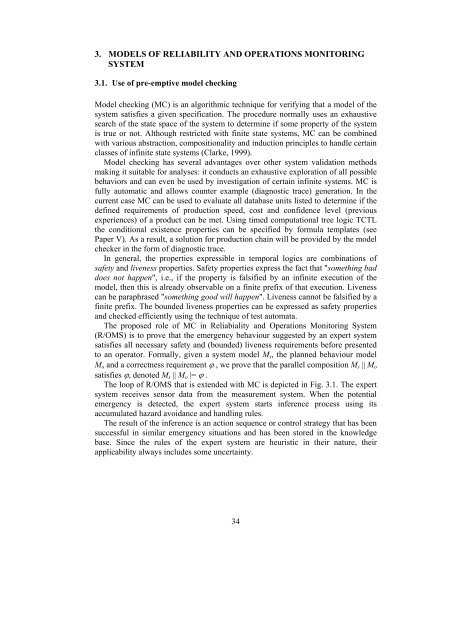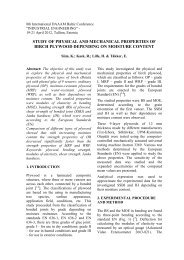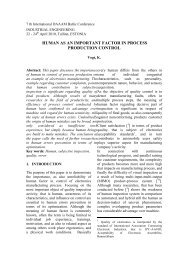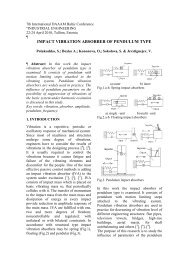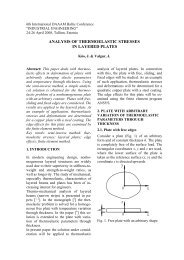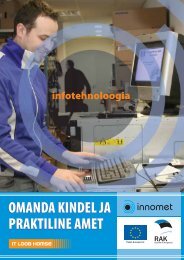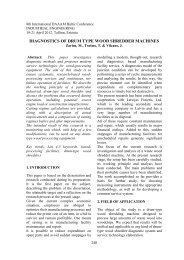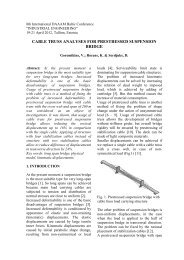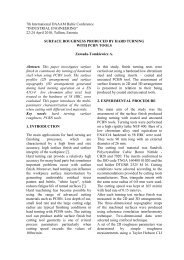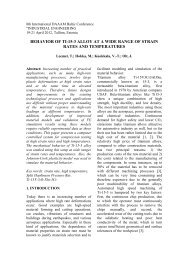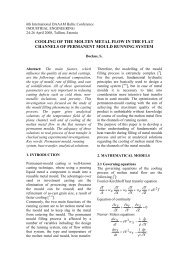Overview in PDF format - Tallinna Tehnikaülikool
Overview in PDF format - Tallinna Tehnikaülikool
Overview in PDF format - Tallinna Tehnikaülikool
You also want an ePaper? Increase the reach of your titles
YUMPU automatically turns print PDFs into web optimized ePapers that Google loves.
3. MODELS OF RELIABILITY AND OPERATIONS MONITORINGSYSTEM3.1. Use of pre-emptive model check<strong>in</strong>gModel check<strong>in</strong>g (MC) is an algorithmic technique for verify<strong>in</strong>g that a model of thesystem satisfies a given specification. The procedure normally uses an exhaustivesearch of the state space of the system to determ<strong>in</strong>e if some property of the systemis true or not. Although restricted with f<strong>in</strong>ite state systems, MC can be comb<strong>in</strong>edwith various abstraction, compositionality and <strong>in</strong>duction pr<strong>in</strong>ciples to handle certa<strong>in</strong>classes of <strong>in</strong>f<strong>in</strong>ite state systems (Clarke, 1999).Model check<strong>in</strong>g has several advantages over other system validation methodsmak<strong>in</strong>g it suitable for analyses: it conducts an exhaustive exploration of all possiblebehaviors and can even be used by <strong>in</strong>vestigation of certa<strong>in</strong> <strong>in</strong>f<strong>in</strong>ite systems. MC isfully automatic and allows counter example (diagnostic trace) generation. In thecurrent case MC can be used to evaluate all database units listed to determ<strong>in</strong>e if thedef<strong>in</strong>ed requirements of production speed, cost and confidence level (previousexperiences) of a product can be met. Us<strong>in</strong>g timed computational tree logic TCTLthe conditional existence properties can be specified by formula templates (seePaper V). As a result, a solution for production cha<strong>in</strong> will be provided by the modelchecker <strong>in</strong> the form of diagnostic trace.In general, the properties expressible <strong>in</strong> temporal logics are comb<strong>in</strong>ations ofsafety and liveness properties. Safety properties express the fact that "someth<strong>in</strong>g baddoes not happen", i.e., if the property is falsified by an <strong>in</strong>f<strong>in</strong>ite execution of themodel, then this is already observable on a f<strong>in</strong>ite prefix of that execution. Livenesscan be paraphrased "someth<strong>in</strong>g good will happen". Liveness cannot be falsified by af<strong>in</strong>ite prefix. The bounded liveness properties can be expressed as safety propertiesand checked efficiently us<strong>in</strong>g the technique of test automata.The proposed role of MC <strong>in</strong> Reliabiality and Operations Monitor<strong>in</strong>g System(R/OMS) is to prove that the emergency behaviour suggested by an expert systemsatisfies all necessary safety and (bounded) liveness requirements before presentedto an operator. Formally, given a system model M s , the planned behaviour modelM o and a correctness requirement ϕ , we prove that the parallel composition M s || M osatisfies ϕ, denoted M s || M o |= ϕ .The loop of R/OMS that is extended with MC is depicted <strong>in</strong> Fig. 3.1. The expertsystem receives sensor data from the measurement system. When the potentialemergency is detected, the expert system starts <strong>in</strong>ference process us<strong>in</strong>g itsaccumulated hazard avoidance and handl<strong>in</strong>g rules.The result of the <strong>in</strong>ference is an action sequence or control strategy that has beensuccessful <strong>in</strong> similar emergency situations and has been stored <strong>in</strong> the knowledgebase. S<strong>in</strong>ce the rules of the expert system are heuristic <strong>in</strong> their nature, theirapplicability always <strong>in</strong>cludes some uncerta<strong>in</strong>ty.34


